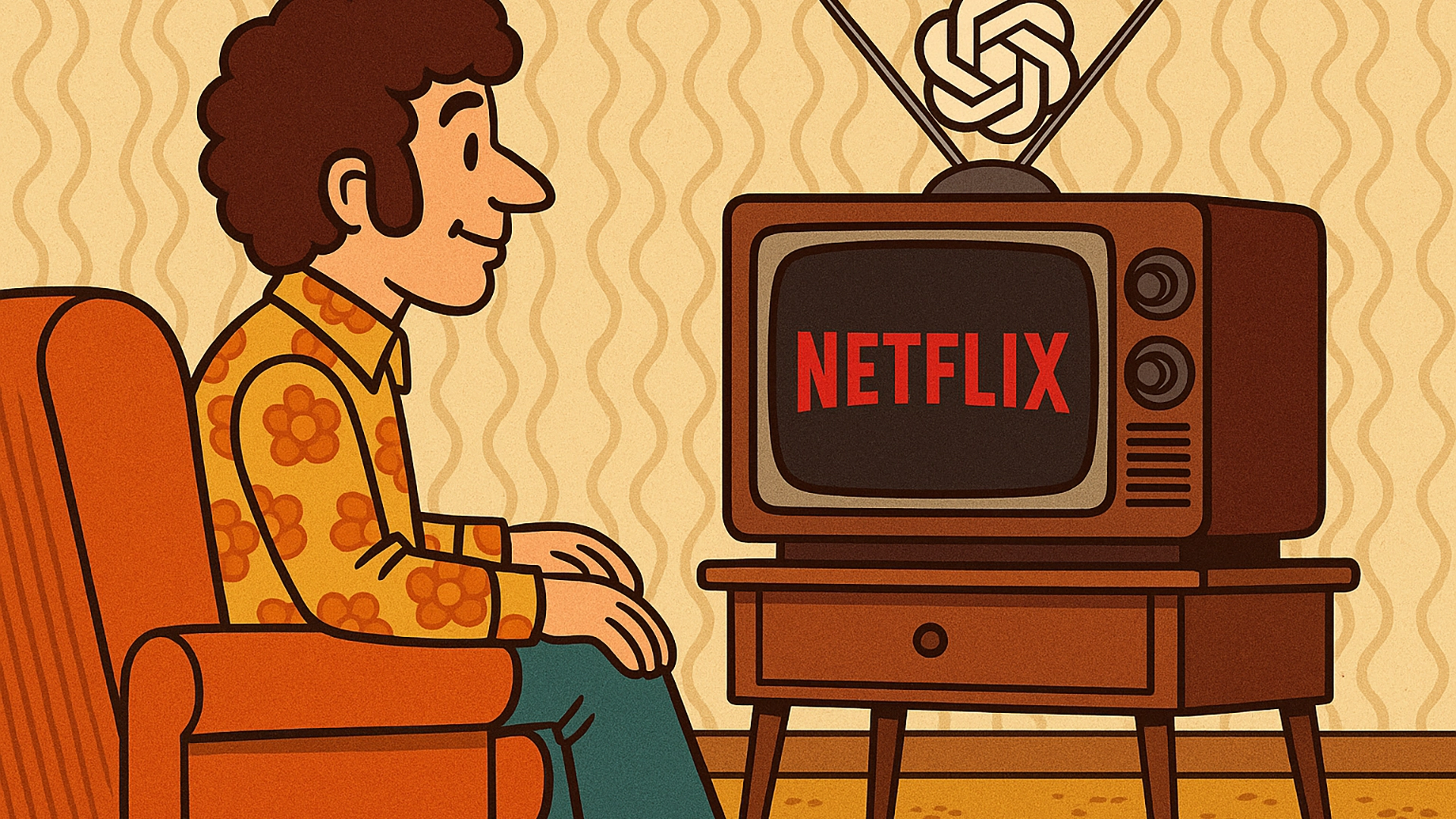
Image generated with ChatGPT
Opinion: Streaming Is Starting to Look a Lot Like Cable TV
The arrival of ad-supported plans, live content, and the high prices of streaming platforms are turning what was once modern, on-demand, and inexpensive into what we didn’t like about cable television.
Do you remember the first Netflix show you watched? The king of video streaming began offering its popular streaming services back in 2007, but started gaining widespread popularity in 2013 with original series like House of Cards and Orange Is the New Black.
Around that time, the platform had just expanded to Canada, Latin America, and the U.K., promoting itself as an affordable, ad-free alternative to traditional television. Millions of users began downloading the app on their laptops to watch their favorite shows and enjoy its ad-free entertainment. Netflix’s subscriber base grew from 18 million in 2010 to over 200 million by 2020.
Soon, cable TV—where viewers had no control over ads and couldn’t watch their favorite shows on demand—started to seem outdated, inconvenient, and expensive. As the streaming industry boomed, new competitors, like Apple, Disney+, HBO, and Amazon Prime Video, joined the club.
However, over the years, these popular platforms have evolved and adjusted their business models, increasing subscription prices, introducing more ads—now powered by AI—and offering more live content. All of a sudden, video streaming services are starting to resemble traditional cable TV with just a modern twist.
Ads Everywhere
Do you remember how annoying it was to watch a show on TV, and a sequence of commercials interrupted the big reveal of the secret that had tormented the protagonist with a Head and Shoulders commercial or the new Happy Meal promo? Well, we are going back to these experiences on streaming platforms—only worse, thanks to new AI-powered tools.
A few days ago, YouTube, which has also been evolving into a TV alternative, announced that it’s rolling out a new AI tool called Peak Point that has been designed to identify critical moments in a video—scanning transcripts and visuals—to place ads when users are most engaged.
While this may sound like a relief or a distant problem for those who pay YouTube Premium or prefer other platforms, let us remember how easily these tech companies replicate strategies and how they keep increasing prices and adding more “cheaper-with-ads” plans.
The Ad-Supported Plans Epidemic
Netflix first introduced an ad-supported tier of its memberships in 2022, in partnership with Microsoft—just for a while—, when its subscription growth was slowing down. Just a few months later, about 30% of users switched to the cheaper ad-supported program—also pushed by the end of the password sharing “benefit”—, and 40% of new subscribers preferred this plan as well.
And just like that, they tricked us into paying to watch ads, and we are already getting used to it. A few days ago, Netflix announced a significant increase in the basic ad-supported plan, which went from 40 million users worldwide in 2024 to 94 million users by this month.
The successful business strategy, pioneered by Hulu years before, has been replicated by other streaming platforms such as Disney+, Amazon Prime Video, Peacock, and Paramount.
Spotify—which has been adding more video content to its platform in the past few months—has been including ads only on its podcast for premium users, but for how long? Last month, the rumor that the platform was going to show ads to premium users on music spread quickly on social media, and Spotify had to clarify that premium music will remain ad-free. “Why do I feel like this is gonna age poorly like the Netflix password tweet?” wrote one user in a comment, referring to that post when Netflix wrote “Love is sharing a password.”
There is a rumor circulating that Spotify is putting ads into premium music listening. This rumor is false. Premium music listening is and will remain ad-free.
— Spotify (@Spotify) April 8, 2025
It’s Getting More Expensive
Paying for a streaming service used to be cheaper than cable TV. But that was before we had so many platforms with high-quality content. The fomo is huge when it comes to popular streaming shows, and users don’t want to miss out—but it’s hurting their wallets.
The Last of Us and White Lotus on HBO Max—it’s not Max anymore, keep up!—Your Friends & Neighbors on Apple TV, Adolescence on Netflix, and now The Bear’s season 4 is coming to Hulu next month. According to a survey report shared by Forbes from last year, on average, Americans pay around $77 per month, around $924 in a year, on streaming subscriptions.
Not only are users paying for multiple platforms, but these are also becoming more expensive, especially for those who want to avoid ads. In January, Netflix raised its plan prices, increasing the ad-supported tier from $6.99 to $7.99 per month, and its highest-priced premium tier from $22.99 to $24.99 per month. Adding an Extra Member now costs $8.99.
Netflix includes all its content within its subscription plans, but it’s also important to factor in the cost of those extra titles that many users are tempted to pay for on other platforms. That movie you’re really eager to watch might be available on Apple TV or Prime Video, but for an additional fee. If it’s an older film, you might get lucky and rent it for just $2.99 for a few hours, but if it’s a newer release, it could cost as much as $19.99—and hopefully you won’t feel tempted to buy it or crave several others.
The Streaming Bundles Solution
As a way to “help” consumers reduce costs and better combine services, streaming bundles have become increasingly popular. A few days ago, ESPN announced a new subscription plan including all of its content for $29.99, and Disney offered streamers the opportunity to bundle it with Disney+ and Hulu for $35.99 per month.
A recent study revealed that 75% of Americans prefer these streaming bundles, even when they aren’t necessarily cheaper or more convenient, because they allow them to manage all their subscriptions in one place. The streaming bundles also take us back to the era of cable TV. Remember when we used to buy TV packages from cable providers?
The Disney+, Hulu and Max streaming bundle has been launched, priced at a discount of up to 38%
• $16.99/month with ads
• $29.99/month without ads pic.twitter.com/YwZUUQM2hX— DiscussingFilm (@DiscussingFilm) July 25, 2024
As cable TV consumers, we used to—and still do—subscribe to multiple plans, including certain TV channels. The basic packages included all local channels, and expanded or premium plans offered the good stuff like HBO or MTV for a higher price. Now, certain cable TV packages include streaming services, just as streaming services are offering TV channels.
Live Content
The experience of having to be physically in front of the TV to watch certain types of content in real time—a hallmark of traditional cable television—is increasingly making its way to video streaming platforms as well.
Not only through the broadcasting of sports games available on Apple TV, ESPN+, or Peacock, but also through other types of live content now arriving on Netflix. The streaming giant announced a few days ago that it will add more live streaming content, including award shows, comedy shows, and more WWE wrestling.
ESPN will also include cable TV channels on its new platform, and Google has been adding more shows and updates to its YouTube TV and Google TV platforms—and recently launched a new TV and film production project called 100 zeros. It seems like it’s only a matter of time before we watch live news and soap operas on Netflix or Disney+.
A Modern TV Experience
Streaming platforms are evolving toward cable television, while cable TV is increasingly adopting streaming-style features. These entities, which once seemed like different species, are becoming more alike every day and are merging into a new era of modern television.
Everything indicates that the video content consumption business cannot survive without advertising. It seems we won’t escape the annoying ads, and the idea of watching series and movies without commercial breaks will become an increasingly exclusive practice for users with larger budgets.
Soon, we’ll have even more content that will keep us glued to our TV screens. Just as Bonanza or The Jeffersons made many people stay home to avoid missing any detail of the latest episode of those hit shows from the ’70s, in a short time we might also find ourselves stuck to our flat-screen TVs, unable to skip commercial breaks during the most exciting moments or afraid of missing a minute of a live broadcast on our streaming platform.


 Previous Story
Previous Story

 Latest articles
Latest articles 